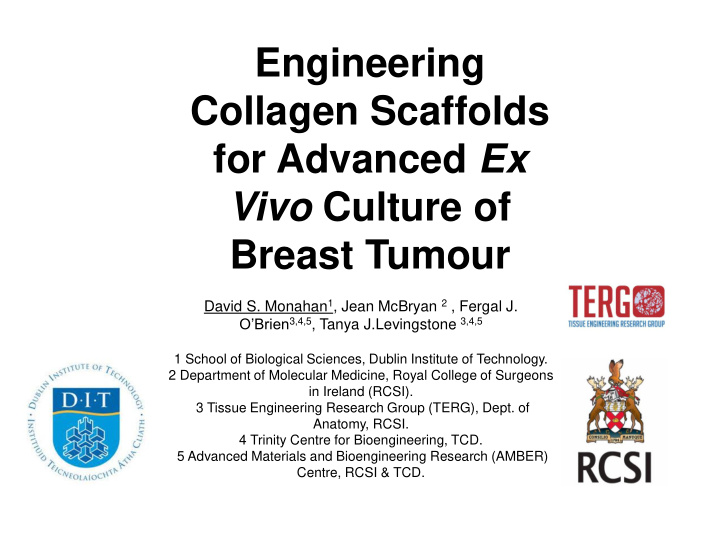



Engineering Collagen Scaffolds for Advanced Ex Vivo Culture of Breast Tumour David S. Monahan 1 , Jean McBryan 2 , Fergal J. O’Brien 3,4,5 , Tanya J.Levingstone 3,4,5 1 School of Biological Sciences, Dublin Institute of Technology. 2 Department of Molecular Medicine, Royal College of Surgeons in Ireland (RCSI). 3 Tissue Engineering Research Group (TERG), Dept. of Anatomy, RCSI. 4 Trinity Centre for Bioengineering, TCD. 5 Advanced Materials and Bioengineering Research (AMBER) Centre, RCSI & TCD.
Introduction 1.67 million cases of breast cancer per year with 522,000 deaths 1 ◦ 12% of all cancer cases ◦ Most common cancer in women ◦ 2 nd most common cancer world wide Average of 2,883 new cases in Ireland annually ◦ 1/10 women ◦ 690 deaths (16%) 1. Ferlay et al, Int J Cancer . 2015; 136: 359-86.
Introduction The tumour microenvironment has an important role in cancer development 2 ◦ Extracellular matrix (ECM) ◦ Cells – Immune cells, adipocytes, endothelium, fibroblasts ECM altered during cancer progression 2 ◦ Promotes adhesion and signalling in cancer cells ◦ Stiffer matrix due to enzyme release 2. Inusa-Rodríguez and Oskarsson, Adv Drug Deliv Rev. 2016 ; 97: 41-55.
Introduction Traditionally, cells are cultured in plastic flasks in a 2D environment. Limitations of 2D culture include ◦ Lack of cell-cell interactions ◦ Lack of cell-matrix interactions ◦ Lack of mechanical signals
Introduction Advantages of 3D culture ◦ Mimics the extracellular matrix ◦ Provides cell-cell interactions ◦ Provides cell-matrix interactions ◦ Reduces drug development costs and late stage drug failures ◦ Reduces animal use ◦ More accurate investigation of tumour biology
Introduction ◦ Previous success with a 3D gelatin based ex vivo culture system 3 ◦ Gelatin poorly resembles the natural ECM ◦ Collagen makes up 1/3 of total proteins in humans ◦ Collagen scaffolds have previously shown success for investigation of metastatic prostate cancer 4 3. Dean et al , cell cycle. 2012;11:2756-61. 4. Fitzgerald et al , Biomaterials. 2015;66:53-66 .
Aims ◦ Fabricate a range of collagen and collagen/gelatin scaffolds ◦ Characterise the scaffolds in terms of their structural, mechanical and degradation properties ◦ Determine if fresh or frozen tumour samples are optimal for use in this ex vivo culture system ◦ Determine if the addition of fibronectin increases the proliferation of breast tumours
Gelatin 0.5% 0.5% Type 1 Collagen DHT Spongostan Collagen + Collagen + (180 ° C for 48 Collagen 0.1% Gelatin 0.25% Gelatin 0.5% hours) Col + Col + 0.5% Col Col DHT 0.1% Gel 0.25% Gel
Type 1 Gelatin Blend @ Collagen 15,000 RPM 0.05M Acetic Acid Collagen only or Collagen + Gelatin Controlled freezing too -40 ° C Cut Freeze dried Freeze drying sheet to cubes of ~1cm 3 Adapted from 5. Ryan and O’Brien, Biomaterials. 2015;73:296-307.
Methods ◦ Scaffolds were then analysed using: ◦ Porosity ◦ Scanning electron microscopy ◦ Degradation measurements ◦ Mechanical testing ◦ Frozen patient/ fresh xenograft tumours cultured for 5 days on selected scaffolds ◦ H&E and KI67 expression for tumour analysis
0.5% Col Col DHT Col + 0.1% Gel Porosity = 99.41% Porosity = 99.15% Porosity = 99.05% Col + 0.25% Gel Spongostan Porosity = 98.85% Porosity = 98.83%
Fabricated scaffolds have a greater stiffness One-way ANOVA revealed a strong statistical significance between the groups (p<0.001). *Post hoc tukey analysis revealed all scaffolds had a significantly higher stiffness than Spongostan (p<0.05).
Fabricated scaffolds survive longer in culture Degradation rates
Frozen patient tumours @ day 5 Patient 2 Patient 3 Patient 1 Original Tumour 0.5% Col Not Cultured Col + 0.1% Gel Spongostan
Fresh xenograft tumours @ day 5 Original tumour 0.5% Col Col + 0.1% Gel Col + 0.25% Gel Spongostan Col (f) Col + 0.1% Gel (f) Example of Ki67
Proliferation maintained across all groups
Conclusions ◦ Collagen and Collagen gelatin scaffolds were successfully fabricated and characterised ◦ The optimal scaffold was determined to be the 0.5% Col + 0.1% Gel scaffold. ◦ Fresh tumours are superior for ex vivo culture ◦ Fibronectin increases proliferation by providing a breast cancer specific environment. ◦ This study presents a novel system for ex vivo breast cancer culture for tumour biology and drug development.
• Small sample size • Lack of human tumours Limitations • Hydroxyapatite to mimic Current bone metastases research • Analysis of culture media – MMPs secretion • Option to test tumour Future response to novel drugs directions • Expansion into other tumour types
References 1. Ferlay J, Soerjomataram I, Dikshit R et al. Cancer incidence and mortality worldwide: Sources, methods and major patterns in GLOBOCAN 2012 . Int J Cancer. 2015; 136: 359-86. 2. Inusa-Rodríguez J, Oskarsson T. The extracellular matrix in breast cancer. Adv Drug Deliv Rev 2016 ; 97: 41-55. 3. Dean JL , McClendon AK , Hickey TE et al . Therapeutic response to CDK4/6 inhibition in breast cancer defined by ex vivo analyses of human tumours . Cell cycle 2012;11:2756-61. 4. Fitzgerald KA, Guo J, Tierney EG et al. The use of collagen based scaffolds to stimulate prostate cancer bone metastases with potential for evaluating delivery of nanoparticulate gene therapeutics. Biomaterials. 2015;66:53-66. 5. Ryan AJ and O’Brien FJ. Insoluble elastin reduces collagen scaffold stiffness, improves viscoelastic properties, and induces a contractile phenotype in smooth muscle cells. Biomaterials 2015;73:296-307
Acknowledgments ◦ My supervisors Dr. Leanne Harris and Dr. Tanya Levingstone ◦ Dr. Jean McBryan for advice with tumour material ◦ Dr. Tony O’Grady and Mr. Colm Buckley for allowing me to use their histology equipment. ◦ Dr. Damir Vareslija, Sinead Cocchiglia and Professor Leonie Young for provision of fresh xenograft tumour material.
Recommend
More recommend